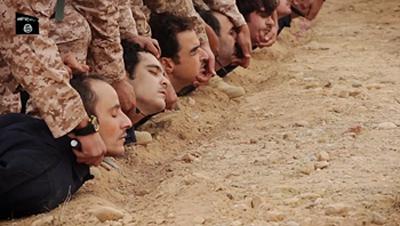The Violence of Faith, Part 1: The Islamic State
 Making use of hidden cell phones, the Islamic State’s sex slaves have made contact with the outside world. There are thousands of them – young Muslim women, some just over 12 years old, snatched from the lifeless arms of their butchered mothers. The brutality and disorientation they continue to suffer – between beatings and rape they hear sermons on why God does this to vile unbelievers – requires removal of all means of suicide. Stealing a moment for a private call, one of the women begs for the merciful bombs of American fighter jets. She does not want to hear that beautiful rumble from high to see her captors punished or that she may once again be free. She begs for the bombs simply so that she and the other women may die. Envious of the 41 women she knew who were successful at suicide, she pleaded, “Please call the plane, we want them [to] kill us, we want to kill ourselves.”
Making use of hidden cell phones, the Islamic State’s sex slaves have made contact with the outside world. There are thousands of them – young Muslim women, some just over 12 years old, snatched from the lifeless arms of their butchered mothers. The brutality and disorientation they continue to suffer – between beatings and rape they hear sermons on why God does this to vile unbelievers – requires removal of all means of suicide. Stealing a moment for a private call, one of the women begs for the merciful bombs of American fighter jets. She does not want to hear that beautiful rumble from high to see her captors punished or that she may once again be free. She begs for the bombs simply so that she and the other women may die. Envious of the 41 women she knew who were successful at suicide, she pleaded, “Please call the plane, we want them [to] kill us, we want to kill ourselves.”
After spending time with refuges Angelina Jolie asks, “What do you say to the 13-year-old girl who describes the warehouses where she and the others lived and would be pulled out, three at a time, to be raped by the men? When her brother found out, he killed himself.”
Even after months of now a billion dollar air campaign by the U.S. military has had little impact on the Islamic State’s control over its people and it ability to recruit and grow. Michael K. Nagata, commander of American Special Operations forces in the Middle East, has sought unconventional sources of expertise in trying to understand the Islamic State’s social power. “We do not understand the movement, and until we do, we are not going to defeat it.” Confidential minutes of phone conferences reveal that the three dozen experts consulted cannot agree on “whether [the Islamic State’s] main objective is ideological or territorial.” In response, General Nagata said he wanted “one hell of a debate.” After six weeks of debate, he explained that he still did “not understand the intangible power of [the Islamic State].” (See Eric Schmitt’s report here.)
Is the intangible power of the Islamic State the power of faith? Is this religious violence we are dealing with? If so, is the culprit Islam, or is this just one more iteration of a violence intrinsic to all monotheism? Is simply ‘religion’ the problem? I think George Packer is getting close to the beginning of an answer. In the New Yorker yesterday:
There’s an undeniable attraction in this horror for a number of young people . . . who want to leave behind the comfort and safety of normal life for the exaltation of the caliphate. The level of its violence hasn’t discouraged new recruits—the numbers keep growing, because extreme violence is part of what makes ISIS so compelling.
Even closer still is Packer’s elaboration today, while interviewed on NPR (I do not yet see any transcript): The Islamic State burned to death Jordanian pilot Lt. Muath al-Kaseasbeh as a sacrifice to unite and excite the group. This was an act of total purification.
*photo from here
No Comments
No comments yet.
RSS feed for comments on this post.
Sorry, the comment form is closed at this time.
Comments Off

